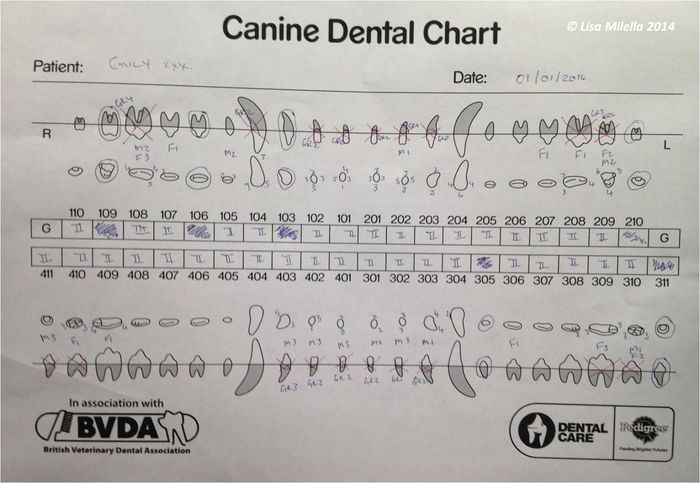Dental Chart Notation
Jump to navigation
Jump to search
| Abbreviation | Term | Explanation |
|---|---|---|
| NAD | No Abnormality Detected | Not always used – usually if there is no pathology, nothing is recorded on the chart. |
| RL | Odontoclastic Resorptive Lesion | The extent of the lesion is shaded in on the chart – the buccal view is used, TR can be used instead. |
| TR | Tooth Resorption | See RL above. |
| GR | Gingival Recession | The gingival margin is drawn down on the root and the measurement is written in mm. eg.GR3. This is drawn on the buccal and/or lingual/palatal aspect. |
| GH | Gingival Hyperplasia | This is measured in mm and the gingival margin is drawn out over the crown of the tooth. This is drawn on the buccal and/or lingual/palatal aspect. |
| UCF | Uncomplicated Crown Fracture | The extent of the fracture is shown on the buccal view of the tooth. |
| CCF | Complicated Crown Fracture | #PE is also sometimes used (fracture with pulp exposure). The fracture line is drawn through the crown of the tooth. |
| W | Wear | (Abrasion or attrition) facet, and the wear is drawn on to the chart. |
| Ca | Caries defect | Since the lesions occur on the occlusal surface of the tooth, the open mouth view/occlusal view is used to shade in the lesion. |
| G I-III | Gingivitis | Graded out of 3 and recorded in the box. |
| PPD | Periodontal Probing Depths | Recorded on the occlusal view of the tooth, a small number representing the depth is written at the corresponding location |
| F 1-3 | Furcation | Exposure. |
| M 1-3 | Mobility | |
| OM | Oral Mass | The extent of the lesion is drawn onto the chart. Either the buccal view or the occlusal view can be used depending on the location of the mass. Measurements of the mass are also recorded. |
| RR | Root Remnants | Visible or felt root remnants during the examination, rr is recorded at the site. |
| Missing teeth | Usually circled, in cases of dispute, it is essential to have a record of missing teeth prior to the procedure so this should always be noted. | |
| X | Extracted teeth | Usually marked with a X. |
Ensure that all abnormal findings are recorded on the chart and, where possible, give details including location, severity, size (mm) & direction.
Download a blank dental chart:
